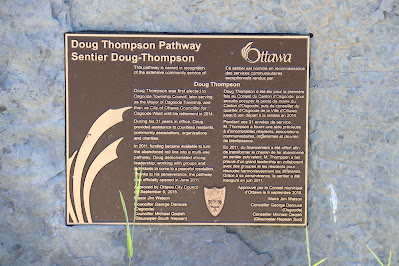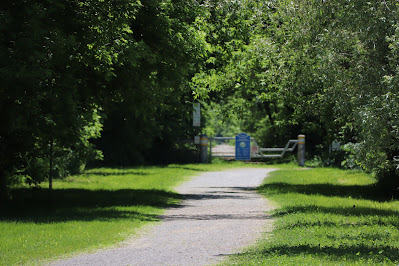In Osgoode, Ontario, the Doug Thompson Pathway, also known as the Osgoode Link Pathway, runs north and south across Osgoode Main Street west of Old George Street. The stone with the associated plaque occupies the south side of Osgoode Main Street just west of the pathway, next to a bench.
Doug Thompson Pathway
This pathway is named in recognition of the extensive community service of Doug Thompson.
Doug Thompson was first elected to Osgoode Township Council, later serving as the Mayor of Osgoode Township, and then as City of Ottawa Councillor for Osgoode Ward until his retirement in 2014.
During his 31 years in office Doug provided assistance to countless residents, community associations, organizations and charities.
In 2011, funding became available to turn the abandoned rail line into a multi-use pathway. Doug demonstrated strong leadership, working with groups and individuals to come to a peaceful resolution. Thanks to his perseverance, the pathway was officially opened in June 2011.
Approved by Ottawa City Council on September 9, 2015.
Mayor Jim Watson
Councillor George Darouze (Osgoode)
Councillor Michael Qaqish (Gloucester-South Nepean)
This pathway is named in recognition of the extensive community service of Doug Thompson.
Doug Thompson was first elected to Osgoode Township Council, later serving as the Mayor of Osgoode Township, and then as City of Ottawa Councillor for Osgoode Ward until his retirement in 2014.
During his 31 years in office Doug provided assistance to countless residents, community associations, organizations and charities.
In 2011, funding became available to turn the abandoned rail line into a multi-use pathway. Doug demonstrated strong leadership, working with groups and individuals to come to a peaceful resolution. Thanks to his perseverance, the pathway was officially opened in June 2011.
Approved by Ottawa City Council on September 9, 2015.
Mayor Jim Watson
Councillor George Darouze (Osgoode)
Councillor Michael Qaqish (Gloucester-South Nepean)
Sentier Doug-Thompson
Ce sentier est nommé en reconnaissance des services communautaires exceptionnels rendus par Doug Thompson.
Doug Thompson a été élu pour la première fois au Conseil du Canton d'Osgoode, pour ensuite occuper la poste de maire du Canton d'Osgoode, puis de conseiller du quartier d'Osgoode de la Ville d'Ottawa, jusqu'à son départ à la retraite en 2014.
Pendant ses 31 années de service, M. Thompson a fourni une aide précieuse à d'innombrable résidents, associations communautaires, organismes et œuvres de bienfaisance.
En 2011, du financement a été offert afin de transformer le chemin de fer abandonné en sentier polyvalent. M. Thompson a fait preuve d'un grand leadership en collaborant avec des grupes et les résidents pour résoudre harmonieusement les différences. Grâce à sa persévérance, le sentier a été inauguré en juin 2011.
Approuvé par le Conseil municipal d'Ottawa le 9 septembre 2015.
Maire Jim Watson
Conseiller George Darouze (Osgoode)
Conseiller Michael Qaqish (Gloucester-Nepean Sud)
Ce sentier est nommé en reconnaissance des services communautaires exceptionnels rendus par Doug Thompson.
Doug Thompson a été élu pour la première fois au Conseil du Canton d'Osgoode, pour ensuite occuper la poste de maire du Canton d'Osgoode, puis de conseiller du quartier d'Osgoode de la Ville d'Ottawa, jusqu'à son départ à la retraite en 2014.
Pendant ses 31 années de service, M. Thompson a fourni une aide précieuse à d'innombrable résidents, associations communautaires, organismes et œuvres de bienfaisance.
En 2011, du financement a été offert afin de transformer le chemin de fer abandonné en sentier polyvalent. M. Thompson a fait preuve d'un grand leadership en collaborant avec des grupes et les résidents pour résoudre harmonieusement les différences. Grâce à sa persévérance, le sentier a été inauguré en juin 2011.
Approuvé par le Conseil municipal d'Ottawa le 9 septembre 2015.
Maire Jim Watson
Conseiller George Darouze (Osgoode)
Conseiller Michael Qaqish (Gloucester-Nepean Sud)
Osgoode Link Pathway
History
In 1997 The Canadian Pacific Railway (CPR) presence in Ottawa came to an end with the last train on the St. Lawrence and Hudson (CP) Prescott subdivision between a point north of Kemptville and Leitrim Road (32.4 km) on the southern edge of Macdonald Cartier Airport (Ottawa). This was the first line to enter Ottawa, then Bytown, in 1854.
In 2005/2006, the City of Ottawa purchased the Prescott subdivision from Canadian Pacific Railways to preserve it for a future transportation/pathway corridor. The Prescott subdivision (also known as the Osgoode Link) was identified as a priority pathway corridor in the City of Ottawa Rural Pathways Master Plan (2007), Ottawa Cycling Master Plan (2009) and the Ottawa Pedestrian Master Plan (2009). Design and construction was initiated in 2010 and the pathway was officially open in the Spring of 2011.
History
In 1997 The Canadian Pacific Railway (CPR) presence in Ottawa came to an end with the last train on the St. Lawrence and Hudson (CP) Prescott subdivision between a point north of Kemptville and Leitrim Road (32.4 km) on the southern edge of Macdonald Cartier Airport (Ottawa). This was the first line to enter Ottawa, then Bytown, in 1854.
In 2005/2006, the City of Ottawa purchased the Prescott subdivision from Canadian Pacific Railways to preserve it for a future transportation/pathway corridor. The Prescott subdivision (also known as the Osgoode Link) was identified as a priority pathway corridor in the City of Ottawa Rural Pathways Master Plan (2007), Ottawa Cycling Master Plan (2009) and the Ottawa Pedestrian Master Plan (2009). Design and construction was initiated in 2010 and the pathway was officially open in the Spring of 2011.
Sentier de liaison Osgoode
Historique
Le dernier train sur la subdivision St. Lawrence et Hudson (CP) Prescott, entre un point au nord de Kemptviille et le chemin Leitrim (32,4 km) à l'extrémité sud de l'aéroport Macdonald-Cartier (Ottawa), a marqué, en 1997, la fin de la présence à Ottawa de la compagnie de chemin de fer Canadien Pacifique limitée (CPR). Cette ligne ferroviaire avait été la première à se rendre à Ottawa, alors appelée Bytown en 1854.
En 2005-2006, la Ville d'Ottawa a acheté la subdivision Prescott de Canadien Pacifique Limitée, afin de la préserver un vue d'un futur corridor d'accès aux sentiers et aux transports. La subdivision de Prescott (également appelé le sentier Osgooge) a été désignée comme corridor et voie d'accès prioritaire dans le City of Ottawa Rural Pathways Master Plan (plan directeur des sentiers rurauz de la Ville d'Ottawa) (2007), le Plan directeur sur le cyclisme d'Ottawa (2008), le Plan directeru des transports d'Ottawa (2008) et le Plan de la circulation piétonnière d'Ottawa (2009). En 2009, la Ville d'Ottawa a obtenu un financement du Programme du fonds de stimulation de l'infrastructure (FSI) fédéral-provincial lui permettant de condevoir et de construire le sentier de liaison Osgoode. Les travaux de conception et de construction ont débuté en 2010 et le sentier a officiellement été overty printemps 2011.
Historique
Le dernier train sur la subdivision St. Lawrence et Hudson (CP) Prescott, entre un point au nord de Kemptviille et le chemin Leitrim (32,4 km) à l'extrémité sud de l'aéroport Macdonald-Cartier (Ottawa), a marqué, en 1997, la fin de la présence à Ottawa de la compagnie de chemin de fer Canadien Pacifique limitée (CPR). Cette ligne ferroviaire avait été la première à se rendre à Ottawa, alors appelée Bytown en 1854.
En 2005-2006, la Ville d'Ottawa a acheté la subdivision Prescott de Canadien Pacifique Limitée, afin de la préserver un vue d'un futur corridor d'accès aux sentiers et aux transports. La subdivision de Prescott (également appelé le sentier Osgooge) a été désignée comme corridor et voie d'accès prioritaire dans le City of Ottawa Rural Pathways Master Plan (plan directeur des sentiers rurauz de la Ville d'Ottawa) (2007), le Plan directeur sur le cyclisme d'Ottawa (2008), le Plan directeru des transports d'Ottawa (2008) et le Plan de la circulation piétonnière d'Ottawa (2009). En 2009, la Ville d'Ottawa a obtenu un financement du Programme du fonds de stimulation de l'infrastructure (FSI) fédéral-provincial lui permettant de condevoir et de construire le sentier de liaison Osgoode. Les travaux de conception et de construction ont débuté en 2010 et le sentier a officiellement été overty printemps 2011.


















